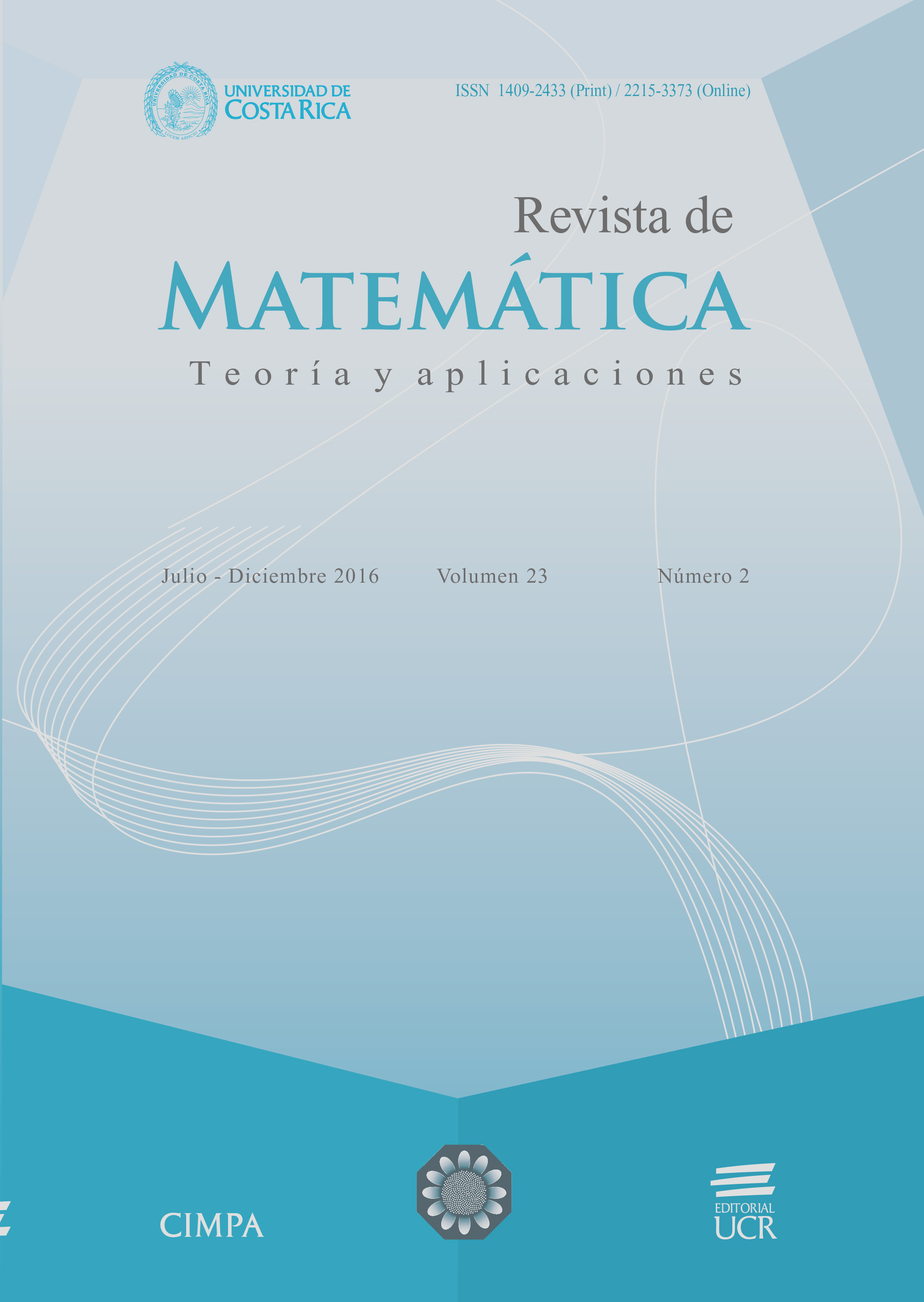Abstract
In this paper we introduce and analyze the Local Discontinuous Galerkin (LDG) method for the Fokker-Planck equation with homogeneous boundary conditions. In particular, we employ a mixed formulation in which the main unknowns are given by the probability current and the probability density function. We apply known results from functional analysis, to establish that the discrete scheme is well-posed. In addition, error estimates are proved for the fully-discrete method using backward Euler time stepping. Finally, we provide numerical examples exhibiting the good performance of the proposed scheme.
References
Arnold, D.N. (1982) “An interior penalty finite element method with discontinuous elements”, SIAM J. Numer. Anal. 19(4): 742–760.
Arnold, D.N.; Brezzi, F.; Cockburn, B.; Marini, L.D. (2002) “Unified analysis of discontinuous Galerkin methods for elliptic problems”, SIAM J. Numer. Anal. 39(5): 1749–1779.
Boffi, D.; Brezzi, F.; Fortin, M. (2013) Mixed Finite Element Methods and Applications. Springer Series in Computational Mathematics, Springer, Heidelberg.
Castillo, P.; Cockburn, B.; Perugia, I; Schötzau, D. (2000) “An a priori error analysis of the local discontinuous Galerkin method for elliptic problems”, SIAM J. Numer. Anal. 38(5): 1676–1706.
Castillo, P.; Cockburn, B.; Schötzau, D.; Schwab, Ch. (2002) “Optimal a priori error estimates for the hp-version of the local discontinuous Galerkin method for convection-diffusion problems”, Math. Comp. 71(238): 455–478.
Cockburn, B.; Dawson, C. (2000) “Some extensions of the local discontinuous Galerkin method for convection diffusion equations in multidimensions”, in: J. Whiteman (Ed.) Conference on the Mathematics of Finite Elements and Applications: MAFELAP X, Elsevier: 225–238.
Cockburn, B.; Kanschat, G.; Perugia, I.; Schötzau, D. (2001) “Superconvergence of the local discontinuous Galerkin method for elliptic problems on Cartesian grids”, SIAM J. Numer. Anal. 39(1): 264–285.
Cockburn, B.; Shu, C.W. (1998) “The Local Discontinuous Galerkin Method for time-dependent convection-diffusion systems”, SIAM J. Numer. Anal. 35(6): 264–285.
Evans, L.C. (2010) Partial Differential Equations, Second Edition. American Mathematical Society, Providence RI, United States.
Gardiner, C.W. (1985) Handbook of Stochastic Methods: for Physics, Chemistry and Natural Sciences, Second Edition. Springer Series in Synergetics, Springer-Verlag, Berlin.
Gatica, G.N. (2014) A Simple Introduction to the Mixed Finite Element Method. Theory and Applications. SpringerBriefs in Mathematics, Springer Cham Heidelberg.
Griffiths, D.J. (2005) Introduction to Quantum Mechanics, Second Edition. Pearson Prentice Hall.
Guzmán, J.; Sequeira, F.A.; Shu, C.-W. (2015) “H(div) conforming and DG methods for incompressible Euler’s equations”, Preprint 2015-19, Centro de Investigación en Ingeniería Matemática (CI2MA), Universidad de Concepción, Chile.
Masud, A.; Bergman, L.A. (2005) “Application of multi-scale finite element methods to the solution of the Fokker-Planck equation”, Comput. Methods Appl. Mech. Engrg. 194(12-16): 1513–1526.
Ortiz, H.H.; Jiménez, F.N.; Posso, A.E. (2015) “Some exact solutions for a unidimensional Fokker-Planck equation by using Lie symmetries", Revista de Matemática: Teoría y Aplicaciones 22(1): 1–20.
Risken, H. (1996) The Fokker-Planck Equation: Methods of Solution and Applications, Second Edition. Springer Series in Synergetics, Springer-Verlag, Berlin.
Sequeira, F.A.; Castillo, P.E. (2012) “Implementación del método LDG para mallas no estructuradas en 3D”, Revista de Matemática: Teoría y Aplicaciones 19(2): 141–156.
Soong, T.T. (1973) Random Differential Equations in Science and Engineering. Academic Press, New York.
Ünal, G.; Sun, J.-Q. (2008) “New exact solutions to the Fokker-Planck- Kolmogorov equation”, Commun. Nonlinear Sci. Numer. Simul. 13(10): 2051–2059.
Vreugdenhil, C.B.; Koren, B. (1993) Numerical Methods for Advection-Diffusion Problems. Notes on Numerical Fluid Mechanics Vol. 45, Braunschweig.
##plugins.facebook.comentarios##

This work is licensed under a Creative Commons Attribution-NonCommercial-ShareAlike 4.0 International License.
Copyright (c) 2016 Revista de Matemática: Teoría y Aplicaciones





